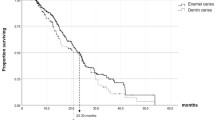Abstract
Objective
To assess the clinical behavior of inactive caries lesion on the occlusal sites of permanent molars over 4–5 years and to estimate the risk for progression of caries-inactive sites compared with sound ones.
Methods
Clinical examinations were conducted at baseline (n = 258) and after 4–5 years and included the recording of dental plaque and dental caries at the occlusal surfaces and the eruption stage of each permanent molar.
Results
One hudred ninety-three schoolchildren were followed (response rate of 74.8%), totalizing 1152 teeth. Of the children, 30.6% (n = 59) presented at least one molar containing an active lesion, filling, or that had been extracted; according to the activity criterion, inactive lesions presented around a twofold increased risk for caries progression than sound surfaces (OR = 2.34 95%CI = 1.51–3.62). Thirteen percent (n = 25) of the children presented at least one molar progressing to dentine cavity, filling, or extraction; according to the severity criterion, inactive caries lesions presented a significantly higher risk for progression when compared with sound surfaces (OR = 2.69, 95% CI = 1.50–4.83).
Conclusion
The vast majority of lesions (85–90%) identified as inactive enamel caries at baseline did not progress over 4–5 years. Despite this fact, it was possible to detect an increased risk for caries progression in caries-inactive occlusal sites compared with the sound ones.
Clinical relevance
Considering the low progression rates, inactive caries lesions do not need a specific caries-controlling treatment and should be monitored longitudinally in the same manner as sound surfaces.

Similar content being viewed by others
References
Amarante E, Raadal M, Espelid I (2008) Impact of diagnostic criteria on the prevalence of dental caries in Norwegian children aged 5, 12 and 18 years. Community Dent Oral Epidemiol 26:87–94. https://doi.org/10.1111/j.1600-0528.1998.tb01933.x.
Ismail AI (1997) Clinical diagnosis of precavitated carious lesions. Community Dent Oral Epidemiol 25:13–23. https://doi.org/10.1111/j.1600-0528.1997.tb00895.x
Carvalho JC, Thylstrup A, Ekstrand KR (1992) Results after 3 years of non-operative occlusal caries treatment of erupting permanent first molars. Community Dent Oral Epidemiol 20(4):187–192
Nyvad B, Machiulskiene V, Baelum V (2003) Construct and predictive validity of clinical caries diagnostic criteria assessing lesion activity. J Dent Res 82:117–122. https://doi.org/10.1177/154405910308200208
Maltz M, Barbachan e Silva B, Carvalho DQ, Volkweis A (2003) Results after two years of non-operative treatment of occlusal surface in children with high caries prevalence. Braz Dent J 14(1):48–54
Ekstrand KR, Martignon S, Ricketts DJ, Qvist V (2007) Detection and activity assessment of primary coronal caries lesions: a methodologic study. Oper Dent 32:225–235. https://doi.org/10.2341/06-63
Guedes RS, Piovesan C, Ardenghi TM, Emmanuelli B, Braga MM, Ekstrand KR, Mendes FM (2014) Validation of visual caries activity assessment: a 2-yr cohort study. J Dent Res 93:101S–107S. https://doi.org/10.1177/0022034514531017
Corrigendum (2015) Corrigendum. J Dent Res 94(12):1784. https://doi.org/10.1177/0022034515607203
Iijima Y, Takagi O (2000) In situ acid resistance of in vivo formed white spot lesions. Caries Res 34:388–394. https://doi.org/10.1159/000016613
Koulourides T, Cameron B (1980) Enamel remineralization as a factor in the pathogenesis of dental caries. J Oral Pathol 9(5):255–269. https://doi.org/10.1111/j.1600-0714.1980.tb00383.x
Maltz M, Scherer SC, Parolo CC, Jardim JJ (2006) Acid susceptibility of arrested enamel lesions: in situ study. Caries Res 40:251–255. https://doi.org/10.1159/000092234
Ferreira Zandoná A, Santiago E, Eckert GJ, Katz BP, Pereira de Oliveira S, Capin OR, Mau M, Zero DT (2012) The natural history of dental caries lesions: a 4-year observational study. J Dent Res 91:841–846. https://doi.org/10.1177/0022034512455030
Zenkner JE, Carvalho JC, Wagner MB, Alves LS, de Oliveira RS, Rocha RO, Maltz M (2016) One-year evaluation of inactive occlusal enamel lesions in children and adolescents. Clin Oral Investig 20(1):133–139. https://doi.org/10.1007/s00784-015-1490-8
Piovesan C, Mendes FM, Antunes JL, Ardenghi TM (2011) Inequalities in the distribution of dental caries among 12-year-old Brazilian schoolchildren. Braz Oral Res 25:69–75. https://doi.org/10.1590/S1806-83242011000100012
Carvalho JC, Ekstrand KR, Thylstrup A (1989) Dental plaque and caries on occlusal surfaces of first permanent molars in relation to stage of eruption. J Dent Res 68:773–779. https://doi.org/10.1177/00220345890680050401
Cook RJ, Sackett DL (1995) The number needed to treat: a clinically useful measure of treatment effect. BMJ 310:452–454. https://doi.org/10.1136/bmj.310.6977.452
Piovesan C, Ardenghi TM, Guedes RS, Ekstrand KR, Braga MM, Mendes FM (2012) Activity assessment has little impact on caries parameters reduction in epidemiological surveys with preschool children. Community Dent Oral Epidemiol 41:204–211. https://doi.org/10.1111/cdoe.12004
Zenkner JA, Alves LS, de Oliveira RS, Bica RH, Wagner MB, Maltz M (2013) Influence of eruption stage and biofilm accumulation on occlusal caries in permanent molars: a generalized estimating equations logistic approach. Caries Res 47:177–182. https://doi.org/10.1159/000345076
Carvalho JC, Mestrinho HD, Oliveira LS, Varjão MM, Aimée N, Qvist V (2017) Validation of the visible occlusal plaque index (VOPI) in estimating caries lesion activity. J Dent 64:37–44. https://doi.org/10.1016/j.jdent.2017.06.003
Funding
This study was funded by the Federal University of Santa Maria.
Author information
Authors and Affiliations
Corresponding author
Ethics declarations
Conflict of interest
Júlio Eduardo do Amaral Zenkner declares that he has no conflict of interest. Ângela Dalla Nora declares that she has no conflict of interest. Luana Severo Alves declares that she has no conflict of interest. Joana Carvalho declares that she has no conflict of interest. Mario B. Wagner declares that he has no conflict of interest. Marisa Maltz declares that she has no conflict of interest.
Ethical approval
The study protocol was approved by the Federal University of Santa Maria Ethics Committee (CAAE 0097.0.243.000-08). All procedures were in accordance with the ethical standards of this research committee and with the 1964 Helsinki declaration and its later amendments or comparable ethical standards.
Informed consent
All subjects and their parents/legal guardians were informed on the research risks and purposes and signed a written informed consent and the children agreed to participate. Patients received dental care by the researchers throughout their participation in the study. No financial incentive was paid for the participants.
Rights and permissions
About this article
Cite this article
Zenkner, J.E.A., Dalla Nora, A., Alves, L.S. et al. Long-term follow-up of inactive occlusal caries lesions: 4-5-year results. Clin Oral Invest 23, 847–853 (2019). https://doi.org/10.1007/s00784-018-2498-7
Received:
Accepted:
Published:
Issue Date:
DOI: https://doi.org/10.1007/s00784-018-2498-7




